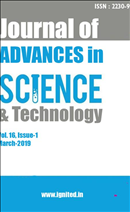Social Media in Academic Libraries: Exploring Its Role and Impact on Library Staff and Services
Keywords:
Social media, Use, Impact, Library, Librarians, StudentsAbstract
This research paper offers a thorough investigation on the application of social media inside library settings, with a specific emphasis on its effects on staff members, services provided and user preferences. Utilizing a mixed method research methodology, the study included both quantitative survey and qualitative interviews to comprehensively investigate role of social media. During the quantitative portion, user website preferences, reasons, duration of usage and obstacles data was gathered. The qualitative portion of the study involved interviews with librarians in order to get insight into their awareness, satisfaction and reason for social media usage. In addition, social media impact on library staff and library services was also evaluated. The findings reveal that majority of student respondent use social media for classes purpose and most of them use social media for more than four hours a day. They find data security as a main obstacle. Most of librarian use social media for communication referencing services and library services marketing and they believe that social media decreased the physical visits of students to the library. More than half of the respondents showed satisfaction to current social media usage in libraries while rest show dissatisfaction. The combined observations provide a substantial contribution to the ongoing conversation on the successful incorporation of social media in contemporary library environments.
Downloads
References
Anderson, K. E. (2015). Getting acquainted with social networks and apps: Snapchat and the rise of ephemeral communication. Library Hi Tech News, 32(10), 6-10.
Anderson, K. E., & Still, J. M. (2011). An introduction to Google plus. Library Hi Tech News, 28(8), 7-10.
Bennett, W. L. (2007). Civic life online: Learning how digital media can engage youth (p. 216). The MIT Press.
Bertot, J. C., Jaeger, P. T., & Hansen, D. (2012). The impact of polices on government social media usage: Issues, challenges, and recommendations. Government information quarterly, 29(1), 30-40.
Carr, C. T., & Hayes, R. A. (2015). Social media: Defining, developing, and divining. Atlantic journal of communication, 23(1), 46-65.
Chen, B., & Bryer, T. (2012). Investigating instructional strategies for using social media in formal and informal learning. International Review of Research in Open and Distributed Learning, 13(1), 87-104.
Chowdhury, G. G., & Chowdhury, S. (2003). Introduction to digital libraries. Facet publishing.
Del Bosque, D., Leif, S. A., & Skarl, S. (2012). Libraries atwitter: Trends in academic library tweeting. Reference services review, 40(2), 199-213.
Duggan, M., Ellison, N. B., Lampe, C., Lenhart, A., & Madden, M. (2015). Social media update 2014. Retrieved from http:// www.pewinternet.org/2015/01/09/social-media-update2014/.
Kaplan, A. M., & Haenlein, M. (2010). Users of the world, unite! The challenges and opportunities of social media. Business horizons, 53(1), 59-68.
Khan, S. A., & Bhatti, R. (2012). Application of social media in marketing of library and information services: A case study from Pakistan. Webology, 9(1), 1-8.
Kietzmann, J. H., Hermkens, K., McCarthy, I. P., & Silvestre, B. S. (2011). Social media? Get serious! Understanding the functional building blocks of social media. Business horizons, 54(3), 241-251.
King, D. L. (2015). Managing your library's social media channels. ALA TechSource.
Mainka, A., Hartmann, S., Orszullok, L., Peters, I., Stallmann, A., & Stock, W. G. (2013). Public libraries in the knowledge society: Core services of libraries in informational world cities. Libri, 63(4), 295-319.
Marchionini, G. (1995). Information seeking in electronic environments (No. 9). Cambridge university press.
Monahan, T., McArdle, G., & Bertolotto, M. (2008). Virtual reality for collaborative e-learning. Computers & Education, 50(4), 1339-1353.
Moorhead, S. A., Hazlett, D. E., Harrison, L., Carroll, J. K., Irwin, A., & Hoving, C. (2013). A new dimension of health care: systematic review of the uses, benefits, and limitations of social media for health communication. Journal of medical Internet research, 15(4), e1933.
Moyo, L. M. (2004). Electronic libraries and the emergence of new service paradigms. The Electronic Library, 22(3), 220-230.
Rane, M. M. Y. (2015). E-Books: a new trend of collection in academic library. International Journal of Multidisciplinary Approach & Studies, 2(2), 106-114.
Roblyer, M. D., McDaniel, M., Webb, M., Herman, J., & Witty, J. V. (2010). Findings on Facebook in higher education: A comparison of college faculty and student uses and perceptions of social networking sites. The Internet and higher education, 13(3), 134-140.
Salomon, D. (2013). Moving on from Facebook: Using Instagram to connect with undergraduates and engage in teaching and learning. College & Research Libraries News, 74(8), 408-412.
Walmiki, R. H., & Ramakrishnegowda, K. C. (2009). ICT infrastructure in university libraries of Karnataka.
Young, S. W. H., & Rossmann, D. (2015). Building library community through social media. Information technology and libraries, 34(1), 20-37.






